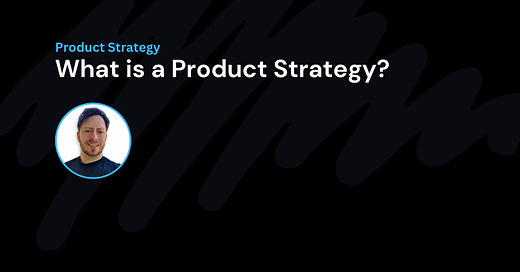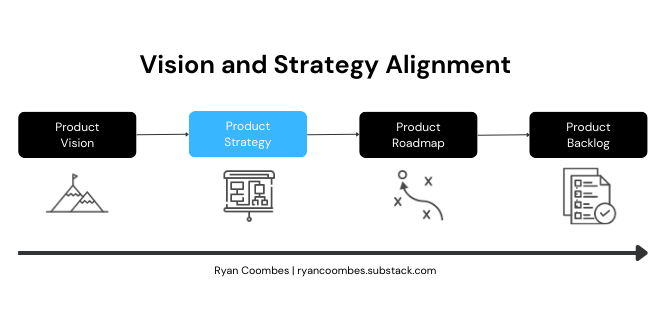Product Strategy Explained: Linking Vision, Strategy, and Roadmap
What is a product strategy, and how does it bridge long-term vision with an actionable roadmap?
Still getting into the hang of posting here on a regular basis, I’m aiming to get 2-3 out a week for the first month, then moving to more of a fixed weekly schedule.
Anyway, let’s get into it!
What is a product strategy, and how does it differ from the roadmap or the vision? I want to cover exactly that and touch on details you should look to include in a strategy and how it fits into the bigger picture.
Definition of Product Strategy
A product strategy is the plan that outlines how the product will make the vision a reality. It’s the bridge between the vision and the roadmap; it will help stakeholders stay aligned with long-term goals and make decisions.
It outlines:
The problem the product will solve for its target customers.
The target market or customer segments.
Positioning: How will the product be positioned and differentiate itself against competitors?
Key initiatives that guide development and growth.
How Does It All Connect?
Let’s look at how a product strategy fits into the larger picture and the relationship with the vision, roadmap, and backlog.
Vision: The vision is the north star—the destination. It’s what aligns the product and stakeholders with the company's goals. You can read more about how to draft a clear vision here.
Strategy: The strategy is what needs to be done to achieve that vision based on research and discovery, and it leads to a set of strategic objectives and initiatives, not all of them development.
Roadmap: The roadmap provides a more detailed plan for executing the product strategy; this will include prioritising initiatives and plotting a timeline based on current capacity and any dependencies.
Backlog: The backlog breaks down the roadmap into more actionable features and tasks. Below is a diagram to show the relationship between these items.
What goes into defining a product strategy?
A lot of research and discovery is needed to inform the strategy. It’s about understanding the opportunities available to you and arriving at a long-term plan that will get you to your destination. Here are some of the foundational things you will need to form your strategy:
Vision & Mission: The overarching purpose and long-term direction that the product aims to achieve, aligning with the company’s goals.
Market Analysis: Research on market trends, competitive landscape, customer needs, and industry conditions.
Target Customers: The specific markets or market segments, or the product is designed to serve, or you want to serve.
Value Proposition: The unique benefits and value that the product will deliver to customers.
Differentiation & Positioning: What is your USP and how will you position the product in the market?
Resource Allocation: Identifying available resources, including talent, time, and budget, to ensure the strategy is feasible.
Once you’ve built your fact base, have an understanding of your opportunities and selected your strategy. You can set strategy goals and pillars, as well as some of the initiatives you’ll need to do in order to make this a success.
Product Strategy Breakdown
To demonstrate what this may look like, I've included the diagram below to help visualise how the strategy will lead you to a set of objectives and pillars. As well as some key initiates you’ll need to complete.
The roadmap process will mean looking at these initiates and prioritising them based on impact while understanding what can realistically be done with the current capacity over a set timeframe and when they can be done when taking into consideration any dependencies you may have.
Each initiative must align with one or more strategic goals to ensure your efforts are moving the product towards the vision, now away from it. If they don’t align with your strategic goals, you’ll need to reconsider them. It’s very possible you may need to include initiatives needed for the short-term survival of the product and incur some level of strategic debt. However, where possible, you need to keep focusing on alignment with the strategy.
Remember that the strategy is not a one time task; it’s a living breathing plan, much like the roadmap, that is subject to change as new information comes to light. It’s important to revisit the strategy on a regular basis to ensure it’s still relevant. I’d recommend doing this quarterly or every 6 months at the latest.
If changes do need to be made, ensure your roadmap and backlog reflect this and you communicate changes to stakeholders as soon as possible.





